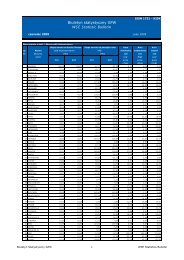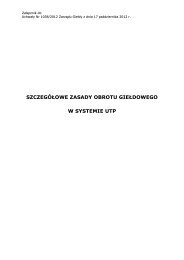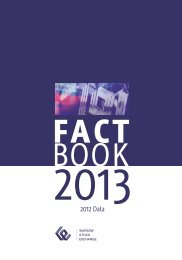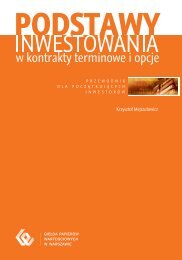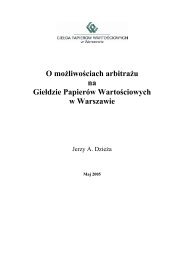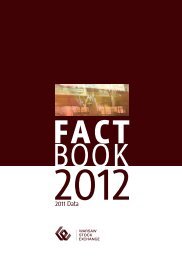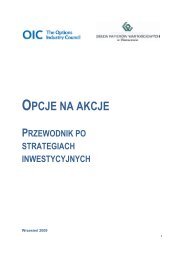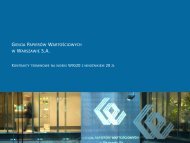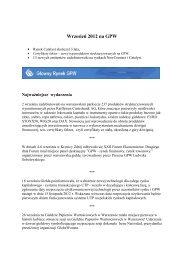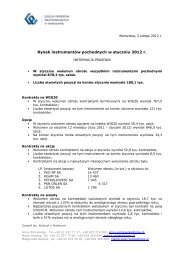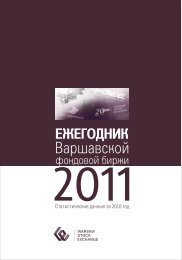D E R I V A T I V E S - GPW
D E R I V A T I V E S - GPW
D E R I V A T I V E S - GPW
Create successful ePaper yourself
Turn your PDF publications into a flip-book with our unique Google optimized e-Paper software.
DERIVATIVES<br />
STRUCTURED PRODUCTS<br />
WARANTS• ETFs<br />
AND SHORT SELLING<br />
ON THE WARSAW STOCK EXCHANGE<br />
WARSAW<br />
STOCK<br />
EXCHANGE
THEWARSAWSTOCKEXCHANGE<br />
AHISTORYOFTHEWSEDERIVATIVES<br />
MARKET<br />
The Warsaw Stock Exchange is the leading and<br />
most dynamic market for derivative instruments<br />
in the CEE region. The WSE derivatives market<br />
was launched in January 1998 with the<br />
introduction of WIG20 futures, i.e. contracts for<br />
the index covering the 20 largest and most<br />
liquid companies listed on the WSE.<br />
In the following years the WSE extended its offer<br />
of derivatives by introducing currency futures in<br />
1998 and single stock futures in 2001.<br />
November 2001 saw the arrival of a new derivative<br />
product, MiniWIG20. Index Participation<br />
Units (IPUs) track the performance of the WIG20<br />
index.<br />
The first options debuted on the Warsaw bourse<br />
in September 2003. They were European-style<br />
options based on the WIG20 index.<br />
In October 2006, the WSE introduced block<br />
trades in all futures and options.<br />
1
In September 2011, the following derivative instruments are<br />
traded on the WSE:<br />
• WIG20 and mWIG40 index futures,<br />
• USD/PLN, EUR/PLN, and CHF/PLN futures,<br />
• 13 single stock futures (ACP, KGH, PGE, PGN, PEO, PKN,<br />
PKO, PZU, TPS, TPE, LTS, OIL, CDR),<br />
• index options (WIG20),<br />
• MiniWIG20 (IPUs).<br />
The WIG20 futures market is the most dynamic segment of<br />
the WSE derivatives market.<br />
On 1 July 2010 the WSE made short sale transactions<br />
available under the new rules, which should further boost<br />
derivatives volumes, enabling more single stock futures to be<br />
listed and single stock options to be offered again in the near<br />
future.<br />
The first ETF (exchange-traded fund), based on the WIG20<br />
index, provided by LYXOR AM, was launched in September<br />
2010 on the WSE.<br />
Currently the WSE’s offer consists of three ETF products<br />
tracking performance of WIG20, DAX and S&P500 indices.<br />
WSEDERIVATIVESTURNOVERVOLUME(INMILIONSOFCONTRACTS)ANDOPENINTEREST(INTHOUSANDSOFCONTRACTS)198– 201<br />
200,0<br />
14.7<br />
15<br />
180,0<br />
160,0<br />
140,0<br />
Volume<br />
Open Interest<br />
12.6<br />
13.9<br />
11.9<br />
14<br />
12<br />
Open Interest (1000' contracts)<br />
120,0<br />
100,0<br />
80,0<br />
60,0<br />
40,0<br />
3.8<br />
3.4<br />
4.4<br />
3.7<br />
5.7<br />
6.7<br />
9.9<br />
10<br />
8<br />
6<br />
4<br />
Volume (million contracts)<br />
20,0<br />
0,0<br />
0.02 0.2<br />
1998<br />
1999<br />
1.5<br />
2000<br />
2001<br />
2002<br />
2003<br />
2004<br />
2005<br />
2006<br />
2007<br />
2008<br />
2009<br />
2010<br />
1-3Q 2011<br />
2<br />
0<br />
2
DERIVATIVES– SHORTSUMARY<br />
In 2010 the trading volume of all derivatives<br />
totaled 14.7 million items, up by 6% year on year.<br />
The number of open interest rose to more than 181<br />
thousand contracts, which indicates a 26%<br />
increase compared with 2009. At the end of 2010<br />
the number of registered NIKs (unique investor<br />
numbers) was 68,672.<br />
The average monthly trading volume was over 1.2 million and<br />
the monthly volume reached its high in May (1.6 million).<br />
In the first half of 2011 index futures were ranked fourth<br />
among futures in Europe.<br />
WIG20 futures continued to be the most popular<br />
of all derivatives. The trading volume for these<br />
instruments exceeded 13.5 million in 2010.<br />
INDEXFUTURESVOLUMESONSELECTEDEUROPEANEXCHANGESINH1201<br />
No. Exchange Turnover Volume in H1 2011 (units)<br />
1 EUREX 217 707 075<br />
2 Liffe NYSE Euronext 47 055 755<br />
3 OMX 15 486 370<br />
4 WSE 6281941<br />
5 SPAIN 4 479 104<br />
6 ITALY 4 072 722<br />
7 NORWAY 3 338 234<br />
8 GREECE 1 373 558<br />
9 HUNGARY 817 760<br />
10 AUSTRIA 147 222<br />
11 ROMANIA 8 965<br />
12 CZECH REPUBLIC 389<br />
Source: respective websites, FESE<br />
3
Apart from index futures, the WSE offers a range of individual<br />
stock and currency futures as well as index participation<br />
units (IPU) based on the WIG20 index. The volume of individual<br />
stock futures for 2010 amounted to 375 thousand.<br />
2011 brought a big increase in turnover volume which totaled<br />
560 thousand by the end of September. Currency derived<br />
futures had a trading volume of 119 thousand. This year’s<br />
cumulative turnover volume at the end of September already<br />
exceeded last year’s result by nearly 30 thousand. Index participation<br />
units reached 36 thousand contracts traded.<br />
In terms of turnover of index and stock derivatives for CEE<br />
region exchanges, the WSE maintains the first position,<br />
leaving Hungary, Austria, Romania and the Czech Republic<br />
behind.<br />
VOLUMEOFTURNOVERININDEXANDSTOCKDERIVATIVESONCEXCHANGES1-3Q201<br />
Turnover Volume<br />
No. Exchange<br />
No of contracts<br />
%<br />
1 WSE 1090561 82.06%<br />
2 HUNGARY 2 076 997 15.63%<br />
3 AUSTRIA 273 332 2.06%<br />
4 ROMANIA 32 177 0.24%<br />
5 CZECH REPUBLIC 1 596 0.01%<br />
Source: respective websites, FESE<br />
4
The dynamics of the WSE futures market (turnover & open interest)<br />
since 2001 is presented below.<br />
FUTURESVOLUMEANDNUMBEROFOPENINTERESTIN201201<br />
–<br />
140<br />
15<br />
14<br />
120<br />
100<br />
Volume<br />
Open Interest<br />
12.23<br />
13.42<br />
11.1<br />
14<br />
12<br />
Open Interest (1000' contracts)<br />
80<br />
60<br />
40<br />
3.75<br />
3.18<br />
4.23<br />
3.61<br />
5.38<br />
6.39<br />
9.48<br />
10<br />
8<br />
6<br />
4<br />
Volume (million contracts)<br />
20<br />
2<br />
0<br />
2001<br />
2002<br />
2003<br />
2004<br />
2005<br />
2006<br />
2007<br />
2008<br />
2009<br />
2010<br />
1-3Q 2011<br />
0<br />
On 10 March 2010 the WSE started publishing a daily report<br />
on concentration of large futures positions.<br />
5
OPTIONSVOLUMEANDNUMBEROFOPENINTERESTIN203– 201<br />
80<br />
0.68<br />
0.72<br />
0.75<br />
0.70<br />
75<br />
0.65<br />
70<br />
0.60<br />
65<br />
60<br />
55<br />
Volume<br />
Open Interest<br />
0.55<br />
0.50<br />
Open Interest (1000' contracts)<br />
50<br />
45<br />
40<br />
35<br />
30<br />
25<br />
20<br />
15<br />
0.25<br />
0.33<br />
0.40<br />
0.33<br />
0.42<br />
0.45<br />
0.40<br />
0.35<br />
0.30<br />
0.25<br />
0.20<br />
0.15<br />
Volume (million contracts)<br />
10<br />
0.08<br />
0.10<br />
5<br />
0.02<br />
0.05<br />
0<br />
2003<br />
2004<br />
2005<br />
2006<br />
2007<br />
2008<br />
2009<br />
2010<br />
1-3Q 2011<br />
0.00<br />
2011 has brought a significant increase in transactions<br />
involving index options. Options are gaining popularity<br />
among Polish investors.<br />
6
INVESTORSTRUCTURE-FUTURESTRADINGIN205– 201<br />
100<br />
WSEINVESTORSTRUCTURE<br />
Every six months the WSE publishes the results of<br />
research on the investor structure. The survey is<br />
carried out among domestic WSE members. At<br />
right are the results for the period 2005 – 2011<br />
for futures and options.<br />
80<br />
60<br />
40<br />
20<br />
0<br />
5<br />
75<br />
20<br />
2005<br />
66<br />
25<br />
9<br />
2006<br />
56<br />
34<br />
10<br />
2007<br />
53<br />
37<br />
10<br />
2008<br />
52<br />
37<br />
11<br />
2009<br />
50 47<br />
36 38<br />
14 15<br />
2010<br />
H1 2011<br />
Foreign Institutional Individual<br />
7
The structure of futures trading remained stable in the period<br />
from 2008 to H1 2011. The share of institutional and foreign<br />
investors in futures trading has grown steadily since 2005.<br />
The biggest market share in H1 2011 belonged to individual<br />
investors – 47%. With respect to trading volume the WSE<br />
experienced an increase amounting to 800 thousand<br />
contracts (2009 – 2010).<br />
Foreign brokers operating on the Polish market were<br />
responsible for 15% of the turnover in H1 2011. In the first half<br />
of 2011 the share of Austrian brokers was over 42% of all<br />
foreign brokers, followed by UK brokers with a share of 31%<br />
and French with 25%.<br />
Domestic institutional investors had a share of 38% of the<br />
total volume in this period: market makers maintained the<br />
highest share, investment funds came second and dealers<br />
third.<br />
8
INVESTORSTRUCTURE-OPTIONSTRADINGIN205-H1201<br />
%<br />
100<br />
In H1 2011 the share of private individuals in options<br />
trading was 61%, the share of institutions 12% and<br />
the share of foreign investors 27%.<br />
80<br />
60<br />
75<br />
71<br />
53<br />
58<br />
65<br />
60 61<br />
Thanks to new Market Makers, the share of foreign<br />
investors in options trading has risen to the highest<br />
level in the history of this market.<br />
40<br />
20<br />
0<br />
1<br />
24<br />
2005<br />
3<br />
26<br />
2006<br />
35<br />
12<br />
2007<br />
30<br />
12<br />
2008<br />
4<br />
31<br />
2009<br />
28<br />
12<br />
2010<br />
12<br />
27<br />
H1 2011<br />
Market Makers played a dominant role among the<br />
domestic financial institutions<br />
The summary below gives a comparison of the<br />
turnover volume (futures & options) by domestic<br />
individual investors, domestic institutional and<br />
foreign investors in 2005-2010<br />
Foreign Institutional Individual<br />
Investors<br />
NUMBEROFCONTRACTS<br />
Instruments 2005 2006 2007 2008 2009 2010<br />
Foreign<br />
Domestic<br />
Individual<br />
Domestic<br />
Institutional<br />
Futures<br />
Options<br />
Futures<br />
Options<br />
Futures<br />
Options<br />
292 577 559 733 896 497 1 208 526 1 449 181 1 871 607<br />
3 428 8 543 45 524 38 738 18 572 65 225<br />
4 022 902 4 190 199 5 255 317 6 404 282 7 245 903 6 841 196<br />
189 371 232 496 209 944 187 428 268 267 330 349<br />
1 054 733 1 576 859 3 165 210 4 472 449 5 106 636 4 900 751<br />
61 636 86 594 139 528 99 046 125 879 151 279<br />
9
WSEDERIVATIVES– BASICRULES<br />
All derivatives are traded in the continuous trading system<br />
between 8:30 a.m. and 5:30 p.m. There is an auction at the<br />
opening and the closing of the session, as is the case with<br />
other instruments traded in the continuous system. After the<br />
closing auction a 5-minute post-auction trading session<br />
follows (5:30 to 5:35 p.m.).<br />
In October 2006 the WSE introduced block trades for futures<br />
and options. They are registered off-session trades. Block<br />
trades in futures may be executed after the first trade in the<br />
order book for a given futures series. Fees are the same as for<br />
transactions in the order book. Price variations can be any<br />
price within static thresholds defined for the order book<br />
transactions (no dynamic thresholds). The minimum volume<br />
for a derivative block trade transaction is 200 contracts.<br />
Block trading facility is available from 8.30 a.m. to 5.50 p.m.<br />
As the organiser of trading, the Warsaw Stock Exchange<br />
develops trading standards for each derivative instrument,<br />
i.e. a detailed description which specifies, for instance, the<br />
calculation method to establish the instrument value, the<br />
first and last day of trading etc. In order to ensure liquidity in<br />
derivatives trading, some WSE members act as market<br />
makers. This means that they sign a relevant agreement with<br />
the WSE under which they are obligated to maintain bid/ask<br />
quotes in the order book. Quotations of derivatives are<br />
relative to dynamic and static price limitations defined<br />
versus the reference price.<br />
Detailed trading rules for derivatives can be found in the<br />
Exchange Rules and Detailed Exchange Trading Rules, or on<br />
the WSE website: w.wse.com.pl.<br />
10
The procedures of settlement and registration as well as<br />
margins are defined by KDPW–CCP, which acts as a clearing<br />
house.<br />
WIG20 index futures expire on the third Friday in March, June,<br />
September and December. Four series of WIG20 futures are<br />
listed in any given moment and three mWIG40 futures. The<br />
multiplier is PLN 10 per index point. The final settlement price is<br />
determined on the expiry date as the arithmetic mean of all<br />
given index values (WIG20, mWIG40) from the last hour of<br />
continuous trading and its value at the session close, having<br />
rejected 5 top and 5 bottom index values.<br />
For single stock futures the three nearest months of the March,<br />
June, September and December cycle are available for trading.<br />
Single stock futures are quoted in PLN per 1 share. The contract<br />
value is the product of the contract price and the number of<br />
shares per contract.<br />
Three currency futures are traded on the WSE: CHF/PLN,<br />
USD/PLN and EUR/PLN. The three nearest calendar months +<br />
the three subsequent months of the March quarterly cycle<br />
(March, June, September, December) (together 6 different<br />
maturities) are available for trading. The last trading day is the<br />
third Friday of the delivery month. Trading in the series of<br />
contracts which expire on that day ends at 10:30 a.m. The<br />
contract size is 10,000 units of currency and the quotation unit<br />
is PLN per 100 EUR, USD or CHF. The final settlement price is the<br />
average EUR, USD, GBP or CHF exchange rate determined by the<br />
National Bank of Poland at the fixing on the last trading day<br />
multiplied by 100, rounded off to the nearest PLN 0.01 (per 100<br />
EUR, USD or CHF).<br />
11
The WSE offers European style WIG20 index options which<br />
means that they can be exercised only on the expiry date. As<br />
is the case with futures, trading in options is supported by<br />
market makers: under a contract signed with the WSE they<br />
are obliged to place sell/buy orders in the order book. The<br />
reference price for options is the theoretical price calculated<br />
according to the Black-Scholes model. WIG20 index options<br />
multiplier, quotation rules, expiry months, last trading day<br />
and final settlement price are the same as for WIG20 index<br />
futures. There is an automatic exercise on expiry date if an<br />
option is in the money. The option owner may waive exercise.<br />
Acquisition of an Index Participation Unit (IPU) is equivalent<br />
to investment in a portfolio of shares issued by twenty<br />
constituent companies of the index concerned. IPUs are<br />
priced in PLN, with the price of one unit being equal to 1/10 of<br />
the WIG20 index value. IPUs offer potential earnings to those<br />
who expect the value of the index to rise (long position, i.e.<br />
purchase of IPUs) as well as those who anticipate a decline<br />
(short position, i.e. selling of IPUs). An index participation<br />
unit is a financial instrument representing all constituent<br />
shares of an index. In terms of the expected rate of return, the<br />
purchase of this instrument is equivalent to a purchase of the<br />
index constituent shares without the need to actually buy the<br />
specific constituent shares. The last trading day is the last<br />
but one exchange trading day in December 2025 and the<br />
expiry date is the next trading date. The settlement price is<br />
the product of the opening value of the underlying<br />
instrument (determined daily as of the second trading day)<br />
and the multiplier.<br />
The exercise date is the date on which the IPU holder<br />
exercises his right or, if there is no early exercise, the trading<br />
day preceding the expiry date. Exercise is allowed on any<br />
trading day until and including the day preceding the expiry<br />
date. The holder may exercise the IPU and receive a payment<br />
from the writer equal to the settlement balance as at the first<br />
exchange trading day following the exercise. The settlement<br />
date is the next working day following the date on which the<br />
settlement price is determined.<br />
As of 21 November 2011 IPUs can be exercised on the futures<br />
contracts expiry dates only.<br />
12
All derivatives are cash settled in PLN.<br />
INDEX FUTURES<br />
Derivatives: abbreviated names<br />
FXYZkrr<br />
Where:<br />
F – type of instrument (futures)<br />
XYZ – abbreviated name of underlying instrument (W20 for WIG20, W40 for mWIG40)<br />
k – delivery month code<br />
rr – last two digits of delivery year<br />
SINGLE STOCK FUTURES<br />
CURRENCY FUTURES<br />
FXYZkrr<br />
Where:<br />
F - type of instrument (futures)<br />
XYZ - abbreviated name of underlying instrument<br />
k - delivery month code<br />
rr – last two digits of delivery year<br />
Underlying instruments (no. of shares per contract): KGH, PEO, PKN, PKO, PZU, TPS, PGE,<br />
CDR, OIL, LTS, ACP – 100, PGN, TPE – 1000<br />
FXYZkrr<br />
Where:<br />
F – type of instrument (futures)<br />
XYZ – abbreviated name of underlying instrument (USD, EUR, CHF)<br />
k – delivery month code<br />
rr – last two digits of delivery year<br />
WIG20 INDEX OPTIONS<br />
OW20Zkrccc<br />
Where:<br />
O – type of instrument (options)<br />
W20 – abbreviated name of underlying instrument WIG20<br />
k – option type and expiry month code<br />
March<br />
June<br />
September<br />
December<br />
r – last digit of expiry year<br />
ccc – exercise price designation<br />
CALL<br />
C<br />
F<br />
I<br />
L<br />
PUT<br />
O<br />
R<br />
U<br />
X<br />
Series of options introduced in the first day: 4 OTM, 4 ITM, 1 ATM<br />
INDEX PARTICIPATION<br />
UNITS (MINIWIG20)<br />
MW20<br />
Where:<br />
M – instrument name<br />
W20 – abbreviated name of underlying instrument<br />
13
FUTURESDELIVERYMONTHCODE<br />
Month Code Month Code<br />
January<br />
F<br />
July<br />
N<br />
February<br />
G<br />
August<br />
Q<br />
March<br />
H<br />
September<br />
U<br />
April<br />
J<br />
October<br />
V<br />
May<br />
K<br />
November<br />
X<br />
June<br />
M<br />
December<br />
Z<br />
WSEDERIVATIVESINTHOMSONREUTERSANDBLOMBERG<br />
DERIVATIVES<br />
FW20<br />
FW40<br />
FACP<br />
FKGH<br />
FPEO<br />
FPGE<br />
FPGN<br />
FPKN<br />
FPKO<br />
FPZU<br />
FTPS<br />
FTPE<br />
FEUR<br />
FUSD<br />
FCHF<br />
MW20<br />
THOMSON REUTERS<br />
0#FW20:<br />
0#MW40:<br />
0#ACPP:<br />
0#KGHM:<br />
0#BAPE:<br />
0#PGEP:<br />
0#PGNI:<br />
0#PKNA:<br />
0#PKOB:<br />
0#PZU:<br />
0#TPSA:<br />
0#TPE:<br />
0#EUPL:<br />
0#USPL:<br />
0# FCHF:<br />
0#IPU.WA:<br />
BLOOMBERG<br />
WIA Index CT<br />
BMA Index CT<br />
ACP=A WX Equity CT<br />
KGH=A WX Equity CT<br />
PEO=A WX Equity CT<br />
PGE=A WX Equity CT<br />
PGN=A WX Equity CT<br />
PKN=A WX Equity CT<br />
PKO=A WX Equity CT<br />
PZU=A WX Equity CT<br />
TPS=A WX Equity CT<br />
TPE=A WXEquity CT<br />
FOA Crncy CT<br />
FSA Crncy CT<br />
CPLA Crncy CT<br />
MWIA Index CT<br />
For more information about WSE derivatives please visit:<br />
www.wse.com.pl or contact: derivatives@wse.com.pl.<br />
14
EXCHANGETRADEDPRODUCTS ONTHEWSE<br />
Structuredproducts<br />
In August 2006, the WSE introduced trading in new<br />
instruments, so-called structured products. The first<br />
products of this kind were structured bonds issued by<br />
Deutsche Bank London, called ‘db Magic Three’. These 3-year<br />
structured bonds were linked to equity, money, commodity<br />
and real estate markets.<br />
The first structured certificate, tracking the performance of<br />
the NTX price index, was issued in March 2007 by ERSTE<br />
Bank.<br />
The biggest issuer of structured products on the WSE, by<br />
number of products, is Raiffeisen Centrobank (RCB) which<br />
launched its first structured certificates in September 2007.<br />
These were open-end certificates, linked to a number of<br />
underlying instruments including a basket of shares and<br />
commodities (e.g. “Eastbasket UK” comprising Ukrainian<br />
and Kazakh markets or “Soft Commodity Basket Focus<br />
Food”), indices (DAX, DJ EuroSTOXX50, CEEC, CECExt, RDX,<br />
NIKKEI225, NASDAQ) and commodities (brent crude oil, gold,<br />
silver, sugar).<br />
In Q1-Q3 2011 the value of trading was PLN 262 million. The<br />
volume of tading was 2.5 million products and the number<br />
of transactions reached 24.5 thousand transactions. The<br />
highest turnover value was recorded on certificates based on<br />
commodities such as silver, gold, brent crude oil, as well as<br />
on indices – WIG20 and DAX (long and short).<br />
During the first three quarters of 2011, a total of 48 new<br />
products were introduced to trading. As of the end of September<br />
2011 there were 177 different structured instruments<br />
traded on the WSE:<br />
• 29 bonds – issued by Barclays Bank, Deutsche Bank,<br />
SecurAsset, Royal Bank of Scotland,<br />
• 148 certificates – issued by RCB, Deutsche Bank,<br />
UniCredit Bank AG, BNP Paribas.<br />
15
NUMBEROFLISTEDSTRUCTUREDPRODUCTS206-201<br />
Structured products on the WSE belong to the cash<br />
market. Bonds are traded on the parallel market in the<br />
single-price system with two auctions and their<br />
trading rules are exactly the same as for zero-coupon<br />
bonds. Certificates are traded on the parallel market<br />
in the continuous trading system. The settlement date<br />
is T+2. The trading rules for certificates are very<br />
similar to the trading rules for shares.<br />
Warants<br />
In 3rd quarter 2011 RCB launched 90 warrants on<br />
polish stocks listed on WSE and WIG20 index. There<br />
are 74 put and 16 call warrants with 3 different expiry<br />
dates.<br />
The prices of these leveraged products are primarily<br />
influen-ced by the performance and volatility of the<br />
underlying asset. Call warrants increase in value<br />
when the underlying asset’s price is rising. Put<br />
warrants benefit when the price of the underlying<br />
asset falls.<br />
260<br />
180<br />
160<br />
140<br />
120<br />
100<br />
80<br />
60<br />
40<br />
20<br />
0<br />
2<br />
December<br />
2006<br />
3<br />
9<br />
December<br />
2007<br />
36<br />
10<br />
December<br />
2008<br />
53<br />
16<br />
December<br />
2009<br />
Certificates Bonds Warrants<br />
124<br />
24<br />
December<br />
2010<br />
90<br />
148<br />
29<br />
September<br />
2011<br />
ListofwarantsonOctober17th201:<br />
Underlying asset: Call : Put:<br />
WIG20 index<br />
PEKAO S.A.<br />
KGHM S.A.<br />
PGE S.A.<br />
PGNiG S.A.<br />
PKN S.A.<br />
PKO BP S.A.<br />
PZU S.A.<br />
TP S.A.<br />
Petrolinvest S.A.<br />
Exipry dates:<br />
20 January 2012, 20 July 2012, 18 January 2013<br />
ETFs<br />
In May 2011 the WSE enlarged the group of Exchange<br />
Traded Funds (ETFs) by launching two new products based<br />
on S&P500 and DAX indices. The issuer of three listed on<br />
the WSE ETFs (including ETF on WIG20 index) is LYXOR Asset<br />
Management. All of them are denominated in PLN and give<br />
investors the possibility to “buy the whole indices”<br />
whether WIG20, DAX or S&P500. The rules are very similar<br />
to share trading rules and to ETFs trading on the other<br />
exchanges. Unit value is 1/10 (in case of the WIG20 index)<br />
or 1/100 (in case of the DAX and S&P500 indices).<br />
For more details about exchange traded products please<br />
contact: struktury@gpw.pl.<br />
16
SHORTSELING<br />
Securitiesavailableforshortsale<br />
The WSE made short sale transactions available<br />
under the new rules from 1 July 2010. Short sale<br />
orders can only be submitted for securities<br />
(shares and bonds) which fulfil the conditions set<br />
out in the WSE Rules. The WSE maintains,<br />
publishes and updates on a daily basis the list of<br />
securities which fulfil these conditions. The list is<br />
published on the WSE website and via the market<br />
information stream used for distribution of<br />
exchange information.<br />
Short sale orders can be submitted for most liquid<br />
shares (including constituent shares of the<br />
WIG20 exchange index) and all Treasury bonds<br />
listed on the Exchange.<br />
Short sale orders of the WSE Members in their<br />
capacity as market makers can be submitted<br />
for a larger list of shares.<br />
Shortsaleflag<br />
Each short sale order must bear a special designation<br />
- short sale flag - to differentiate it from<br />
other broker’s sale orders. In the following<br />
events:<br />
a) a short sale order is submitted for securities<br />
which, at the time of submitting the order, do<br />
not fulfil the eligibility conditions for short<br />
sale orders,<br />
or<br />
b) securities which fulfil the conditions are<br />
subject to a temporary suspension of<br />
accepting of short sale orders, such a short<br />
sale order will be rejected.<br />
Suspensionofaceptingofshortsaleorders<br />
The WSE may temporarity suspend accepting short sale<br />
orders if required by the safety of exchange trading or the<br />
interest of trading participants in particular in case of:<br />
• settlement disruptions,<br />
• a significant decrease of exchange indices or prices of<br />
individual shares over a short period, if the value of a<br />
short sale transaction represents a significant part of the<br />
value of all sale transactions in the given securities<br />
(circuit breakers for short selling).<br />
Informationonshortsaletransactions<br />
The WSE publishes information on short sale transactions in<br />
real time. Information is published via electronic information<br />
distribution mechanisms used by the WSE for distribution of<br />
exchange quotations.<br />
After the closing of a trading session, for all securities<br />
available for short sale orders, the WSE publishes<br />
information about the cumulative volume, value of trading,<br />
and number of short sale transactions. The information is<br />
published via:<br />
a) the electronic information distribution mechanisms;<br />
b) the WSE website;<br />
c) the WSE Daily Bulletin (Ceduła).<br />
For more information please visit: w.wse.com.pl<br />
or contact us at: shortseling@wse.com.pl.<br />
17
Warsaw Stock Exchange<br />
Książęca 4, 00-498 Warsaw, Poland<br />
T: (+48 22) 628 32 32, F: (+48 22) 628 17 54<br />
www.wse.com.pl<br />
Contact:<br />
Krzysztof Mejszutowicz<br />
Head of Equity Derivatives, Market Development Department<br />
T: (+48 22) 537 76 09, (+48 22) 537 72 12<br />
E: krzysztof.mejszutowicz@wse.com.pl<br />
Sebastian Siewiera<br />
Head of ETP and Non-Equity Derivatives,<br />
Market Development Department<br />
T: (+48 22) 537 73 89, (+48 22) 537 72 48<br />
E: sebastian.siewiera@wse.com.pl<br />
The publication of this document does not represent a solicitation nor should it be considered<br />
a suggestion by the Warsaw Stock Exchange as to the suitability of the investment, if any,<br />
described herein.<br />
This document is meant for information purposes and personal use only. The Warsaw Stock<br />
Exchange accepts no liability resulting from any inaccuracies and/or errors and/or omissions<br />
nor for any decisions and/or actions taken by a party based on the information contained in this<br />
document.<br />
18
WARSAW<br />
STOCK<br />
EXCHANGE<br />
ul. Książęca 4, 00-498 Warszawa, Poland<br />
T: (+48 22) 628 32 32<br />
F: (+48 22) 537 77 90<br />
www.wse.com.pl<br />
October 2011



